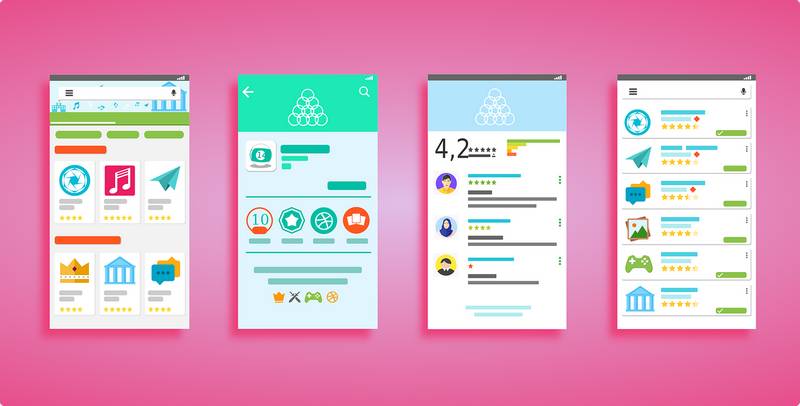Modern life heavily depends on smartphones and mobile apps. Absolutely every operation on a smartphone is performed using one or another sort of application. Messaging, social media, gaming, online banking and even taking photos are based on apps. Let us look at the variety of mobile app types and a few essential steps to consider before building a successful mobile app.

Benefits of native mobile apps
Mobile apps can be device type-dependent and cross-platform. There are two leading device types – Android and iOS. Apps are not compatible between device types, meaning that iOS app will not work on Android and vice versa. Native apps are developed using special framework software and programming languages. Platform-dependent apps have several advantages – they utilize specific device capabilities and thus are more efficient than cross-platform web-based apps. Besides, native apps are distributed through secure app stores and are backed by active communities.
Cross-platform mobile apps
If there is a need to build apps for multiple device types, developers are trying to find suitable tools that would allow supporting various platforms. Usually, tools are based on widely used programming languages such as C++, Java, HTML5, and JS. The main problem with cross-platform apps is that they are more generalized and do not utilize device-specific capabilities. Thus they may run slower and have limited functionality.
On the other hand, cross-platform mobile apps are more natural and cheaper to maintain. However, if the app is performing critical tasks, probably it is better to stick with a natural approach.
Web-based apps
Many services need to be platform-independent. Usually, they are browser-based and created using standard programming tools like HTML, CSS, and JS. The main advantage of web-based apps is that they can be accessed through any browser-compatible device whether it is Android, iOS, or PC. Creation of browser-based apps is fast as many companies heavily support development tools. Accessing a web-based app is convenient by entering the URL into the browser. Since the web app is located in a centralized web server; it can be easily updated without user intervention.

However, web-based apps depend on browser capabilities and internet connection. Growing more substantial, they become clunky, as they do not utilize device capabilities.
Hybrid mobile apps
Hybrid mobile apps come where native and web apps fail. They are somewhat in the middle of both. The hybrid app joins native app benefits and web technologies. Native app allows for achieving excellent performance and functionality, while the web part takes care of connectivity and server-based functionality. Hybrid apps enable integration connecting different device types to centralized web technologies.
Hybrid mobile apps can be challenging to maintain, as device and web parts are usually developed separately. Developers of local device apps need strictly to follow the updates and changes of the web part of the app.
Progressive WEB apps
Progressive web apps (PWA) are a step up from web-based apps. They are adapted to work even if the device is offline. It can be accessed through a URL in the way of the standard web app, but data is cashed within the browser to ensure smooth operation. However, PWA heavily depends on browser capabilities and does not support most of the device functions as it is still based on web technologies.
How are mobile apps created?
Many things need to be taken into account before building a mobile app. The most important is to determine the potential client base. You want your app to be useful and enjoyable. Android or iOS app stores are stuffed with millions of apps and you probably already can find one that is close to your idea. You need to investigate and see if your new app will have a place.

Maybe there already are some apps that do something similar but lack essential functionality. Some particular apps are obsolete and even counterfeit – stuffed with ads without useful features.
Either way, you need to plan:
- The functionality of the mobile app. It has to be convenient, useful, solve some particular user problems, or be entertaining if it is a game. The design has to be catchy and pleasant. Functionality should involve the newest technologies provided by device manufacturers. Design is the key to success.
- Mobile app should also be efficient and avoid being energy hungry. No one wants to drain batteries fast while using an app.
- Plan how your mobile app will earn money. Think about how to monetize your product without annoying clients. It can be a subscription model, one-time purchase fee, ads, and expansions. This is a very important step if you plan to maintain it and provide future updates.
- Think of how you will get feedback from users. It can be direct polls, analytics, feedback requests, ratings, or other metrics. It is essential to measure how good the app is and what needs to be improved.
- Plan updates. If you look at many successful mobile apps, they are continually updating. It may be a complete app update with new versions or service packs. Thinking about mechanisms ahead may help to avoid technical problems.
Even when you create a perfect mobile app, you still need to advertise it. Otherwise, it will get lost among millions of apps. It is better to leave most of these steps to professional mobile app development services. They build mobile apps every day and they know the best tools and methods that are working best. You cannot be a great programmer, designer, and marketing specialist in one person. Creating apps requires careful planning, designing, testing, and fixing bugs.





